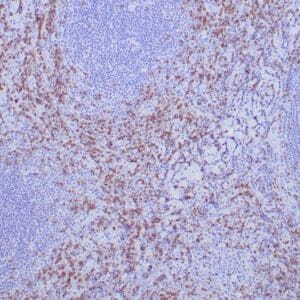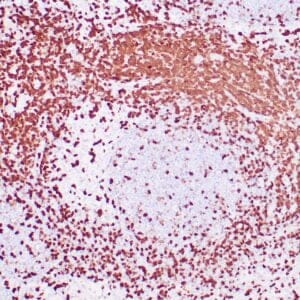| Weight | 1 lbs |
|---|---|
| Dimensions | 9 × 5 × 2 in |
| host | mouse |
| isotype | IgG1 |
| clonality | monoclonal |
| concentration | concentrate, predilute |
| applications | IHC |
| reactivity | human |
| available size | 0.1 mL, 0.5 mL, 1 mL concentrated, 7 mL prediluted |
mouse anti-C4d monoclonal antibody (ZM78) 6042
Price range: $160.00 through $528.00
Antibody summary
- Mouse monoclonal to C4d
- Suitable for: Immunohistochemistry (formalin-fixed, paraffin-embedded tissues)
- Reacts with: Human
- Isotype:IgG1
- Control: Acute rejected kidney transplant
- Visualization: Membrane or cytoplasmic
- 0.1, 0.5, 1.0 mL concentrated, 7 mL prediluted
mouse anti-C4d monoclonal antibody ZM78 6042
| target relevance |
|---|
| Protein names Complement C4-A (Acidic complement C4) (C3 and PZP-like alpha-2-macroglobulin domain-containing protein 2) [Cleaved into: Complement C4 beta chain; Complement C4-A alpha chain; C4a anaphylatoxin; C4b-A; C4d-A; Complement C4 gamma chain] |
| Gene names C4A,C4A CO4 CPAMD2 |
| Mass 192785Da |
| Function FUNCTION: Non-enzymatic component of C3 and C5 convertases and thus essential for the propagation of the classical complement pathway. Covalently binds to immunoglobulins and immune complexes and enhances the solubilization of immune aggregates and the clearance of IC through CR1 on erythrocytes. C4A isotype is responsible for effective binding to form amide bonds with immune aggregates or protein antigens, while C4B isotype catalyzes the transacylation of the thioester carbonyl group to form ester bonds with carbohydrate antigens.; FUNCTION: Derived from proteolytic degradation of complement C4, C4a anaphylatoxin is a mediator of local inflammatory process. It induces the contraction of smooth muscle, increases vascular permeability and causes histamine release from mast cells and basophilic leukocytes. |
| Subellular location SUBCELLULAR LOCATION: Secreted. Synapse {ECO:0000269|PubMed:26814963}. Cell projection, axon {ECO:0000269|PubMed:26814963}. Cell projection, dendrite {ECO:0000269|PubMed:26814963}. |
| Tissues TISSUE SPECIFICITY: Complement component C4 is expressed at highest levels in the liver, at moderate levels in the adrenal cortex, adrenal medulla, thyroid gland, and the kidney, and at lowest levels in the heart, ovary, small intestine, thymus, pancreas and spleen. The extra-hepatic sites of expression may be important for the local protection and inflammatory response. {ECO:0000269|PubMed:11367523}. |
| Structure SUBUNIT: Circulates in blood as a disulfide-linked trimer of an alpha, beta and gamma chain. |
| Post-translational modification PTM: Prior to secretion, the single-chain precursor is enzymatically cleaved to yield non-identical chains alpha, beta and gamma. During activation, the alpha chain is cleaved by C1 into C4a and C4b, and C4b stays linked to the beta and gamma chains. Further degradation of C4b by C1 into the inactive fragments C4c and C4d blocks the generation of C3 convertase. The proteolytic cleavages often are incomplete so that many structural forms can be found in plasma.; PTM: N- and O-glycosylated. O-glycosylated with a core 1 or possibly core 8 glycan. {ECO:0000269|PubMed:12754519, ECO:0000269|PubMed:14760718, ECO:0000269|PubMed:16335952, ECO:0000269|PubMed:18780401, ECO:0000269|PubMed:19139490, ECO:0000269|PubMed:19159218, ECO:0000269|PubMed:19838169, ECO:0000269|PubMed:23234360}. |
| Involvement in disease DISEASE: Complement component 4A deficiency (C4AD) [MIM:614380]: A rare defect of the complement classical pathway associated with the development of autoimmune disorders, mainly systemic lupus with or without associated glomerulonephritis. {ECO:0000269|PubMed:8473511}. Note=The disease is caused by variants affecting the gene represented in this entry.; DISEASE: Systemic lupus erythematosus (SLE) [MIM:152700]: A chronic, relapsing, inflammatory, and often febrile multisystemic disorder of connective tissue, characterized principally by involvement of the skin, joints, kidneys and serosal membranes. It is of unknown etiology, but is thought to represent a failure of the regulatory mechanisms of the autoimmune system. The disease is marked by a wide range of system dysfunctions, an elevated erythrocyte sedimentation rate, and the formation of LE cells in the blood or bone marrow. {ECO:0000269|PubMed:10092831, ECO:0000269|PubMed:17503323}. Note=Disease susceptibility is associated with variants affecting the gene represented in this entry. Interindividual copy-number variation (CNV) of complement component C4 and associated polymorphisms result in different susceptibilities to SLE. The risk of SLE susceptibility has been shown to be significantly increased among subjects with only two copies of total C4. A high copy number is a protective factor against SLE. |
| Target Relevance information above includes information from UniProt accession: P0C0L4 |
| The UniProt Consortium |
Data
 |
| Human rejected kidney stained with anti-C4d antibody using peroxidase-conjugate and DAB chromogen. Note basement membrane/cytoplasmic staining of renal tubules. |
Publications
| pmid | title | authors | citation |
|---|---|---|---|
| We haven't added any publications to our database yet. | |||
Protocols
| relevant to this product |
|---|
| IHC |
Documents
| # | SDS | Certificate | |
|---|---|---|---|
| Please enter your product and batch number here to retrieve product datasheet, SDS, and QC information. | |||
Only logged in customers who have purchased this product may leave a review.















Reviews
There are no reviews yet.